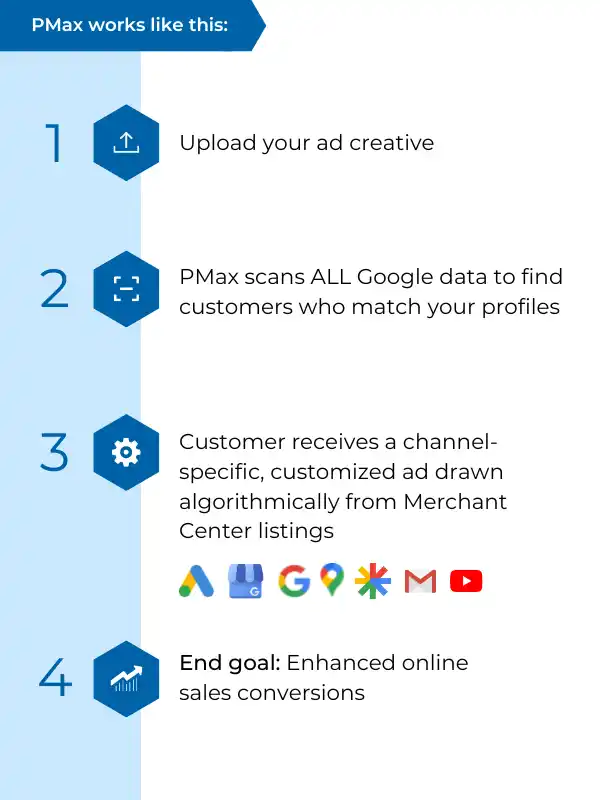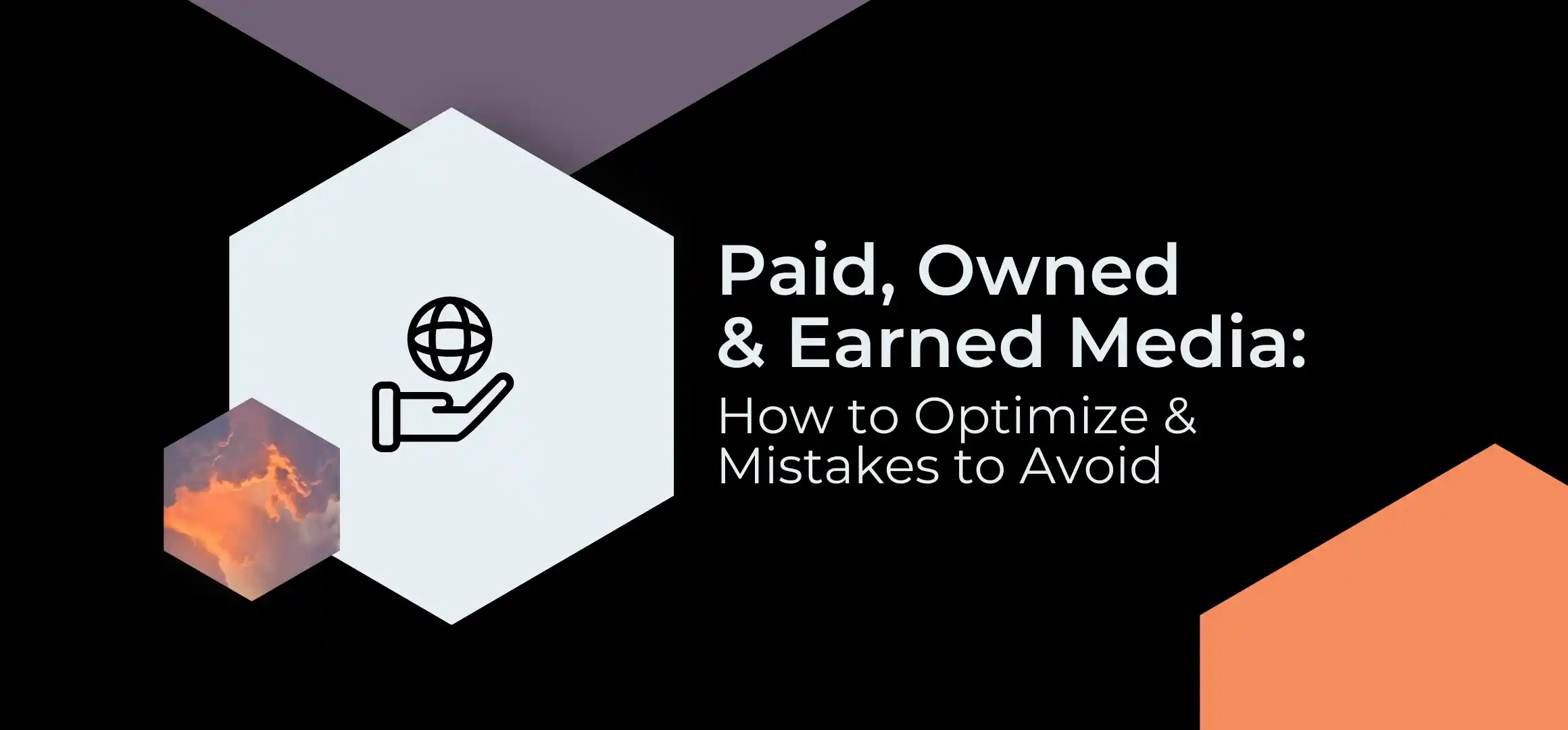
Google has long been synonymous with performance marketing – as a platform, as a channel, as a set of indispensable tools – so it follows that their newest product would be simply called, Performance Max.
As an evolution of its success in the space, Google Performance Max is quickly gaining attention as “the next big thing”. But is it really?
What is Performance Max?
Performance Max (known colloquially as PMax) purports to harness all of the data Google collects on users across all of their product sets, and leverage that data for marketers to reach consumers wherever they are interacting with a Google product.
Ad inventory is accessed in YouTube, Gmail, Google Maps, Google Discovery, Google My Business, Google Display Network, and of course, Google Ads. Performance Max will then create an automated bid strategy that presents brand messaging drawn algorithmically from the Merchant Center listings.
Matching Google data measuring demographics, geographics, psychographic info, and intent, to customers who match your brand profiles, PMax’s goal is to enhance online sales conversions for advertisers.
Kinda sounds like a marketer’s paradise…

Is Google Performance Max any good?
Early success stories suggest so. Industry whispers are growing louder in the thinking that PMax’s machine learning is about to radically evolve the game.
However!
While algorithmic tools are undoubtedly the engine that drives performance marketing, these tools still depend on human input, guidance and interpretation. Without the human element, even a tool as powerful as Performance Max will be no smarter nor more effective.
Apiary believes in the value of human instinct, experience and insight to drive performance marketing success. #PeopleOverPlatforms.
With that in mind, we took a closer look at PMax to see just where it provides upside (or down).
Our initial analysis has found 7 watch outs that we believe performance marketers need to assess before putting all your eggs in the PMax basket.
Let’s start with 3 big cautions you need to be aware of:
Lack of channel control
To utilize PMax is to surrender control of the ad placement within Google. The algorithm uses audience signals from its data to determine where best to find a customer or prospect and serve ads to them within that environment.
That could be Gmail, YouTube or even Google Maps, but performance data is not detailed to the channel level. The algorithm optimizes, but the campaign performance manager responsible for overall performance is not offered that choice.
Lack of visibility
Inside a successful PMax campaign, you’ll see an increase in your conversion goals (revenue, lead generation, engagement, etc) but you’ll receive no actionable data that you can transfer to channels outside of Google.
Where the ads are placed, what messaging is used, and in some cases, even what product, is often not delineated in the performance outcomes.
Optimizing organic performance efforts based on paid insights is simply not possible with PMax.
- When first party data is available (PMax provides none), success signals can be interpreted by demographic, geographic and psychographic subsets to optimize channels where you control the data input, or can extract it.
- Even with traditional paid search or paid social, leveraging third-party data has utility because successes can be attributed to attributes within the data (demographic, geographic, psychographic) and used for optimization
- PMax’s signal data is not tied to specific deployments. It’s aggregated across all platforms that can be accessed by Google – but only those. This limits your learnings.
A 360° analytics dashboard should be the starting line of every performance decision. But Google doesn’t play nice with others, making full-view analytics a very heavy lift.
Ideally, each advertising channel that contributes to the overall performance of the brand can be gathered, aggregated, analyzed, and socialized across platforms.
Google has a wealth of customer data to access, but it remains their customer data.
The upside of PMax is that it’s an unprecedented opportunity to leverage these metrics, but there’s no way to cleanly transfer the learnings outside of your Performance Max campaign.
Lack of creative control
PMax creative delivery is necessarily dynamic. It responds to your customer’s actions and intent signals, which is why Google has to deliver it in templatized ad formats dynamically built with components provided by the brand.
Try this analogy on:
You give Google individual lego blocks (creative assets like video, ad copy, your logo, brand colors), and they decide whether to feed your customer a lego sailboat or a car.
This limits your creative ability to distinguish your brand and serves to genericize the products to match Google’s delivery mechanism.
Additionally, video assets have always been optional in Display campaigns, but in PMax, video is mandatory. In evaluating if PMax is right for your brand, some important questions to ask are:
- Do you have access to creative resources?
- What are the cost implications of producing additional creative?
- Does video facilitate the right expression of your brand?

How can I leverage the benefits of Google Performance Max?
Despite the concerns we shared above, PMax is a powerful tool for accelerating performance. We’re advocating a careful approach – not debating its performance capabilities.
Alongside that big spoonful of caution, there are several scenarios where PMax is particularly attractive.
If one or more of the following factors describes your brand, PMax might be a smart addition to your performance marketing mix:
Limited time or resources
If your channel manager is limited by bandwidth, or you don’t have a dedicated resource managing the channel, allowing Google to place, scale and optimize the campaign is a compelling proposition.
PMax requires significant initial setup, but takes far less resources to optimize and manage over time.
Limited budget
If resources are constrained, funneling all your ad budget and bids through one campaign that searches for the best product feed placements to drive performance can be ideal.
Machine algorithms can never fully replace human decision-making, but they can be a brief substitute to initiate a campaign, scale a new or evolving brand, or support in times of transition.
Test new opportunities
While human control over the breadth of marketing channels is preferred, exploring new opportunities can benefit from algorithmic input.
Utilizing PMax to test new geographies, new customer profiles, even new products, can deliver faster results and lay the groundwork for expanded focus across a broader campaign.
Scale
In addition to utilizing PMax to test new markets, it can be additive to existing campaigns to increase a brand’s scale.
Success that is maximized across existing channels can be supplemented and enhanced by the addition of new channels via PMax.
TL;DR summary of Performance Max
- Performance Max is Google’s next great thing. No question.
- How it works: Upload your ad asset group (video, photography, ad copy, logo, etc) and their machine learning will deliver optimized and channel-specific ad containers anywhere in the Google universe.
- But this smart shopping campaign tool comes with limitations and risks like:
- Lack of channel control
- Lack of visibility
- One-way data signals
- Lack of creative control.
- PMax is a strong candidate for brands who are:
- Operating without a dedicated Google resource, or your channel manager has limited bandwidth
- Facing significant budget constraints, so a campaign that searches for the best placements is compelling
- Prioritizing testing new geographies, new customer profiles, and even new products
- Running existing campaigns with success and are seeking to scale further.
Channels without a strategy are not true success drivers.
Deepen your understanding of your customer, your product, and your market first. That makes it easy to see where PMax fits into your channel mix.




